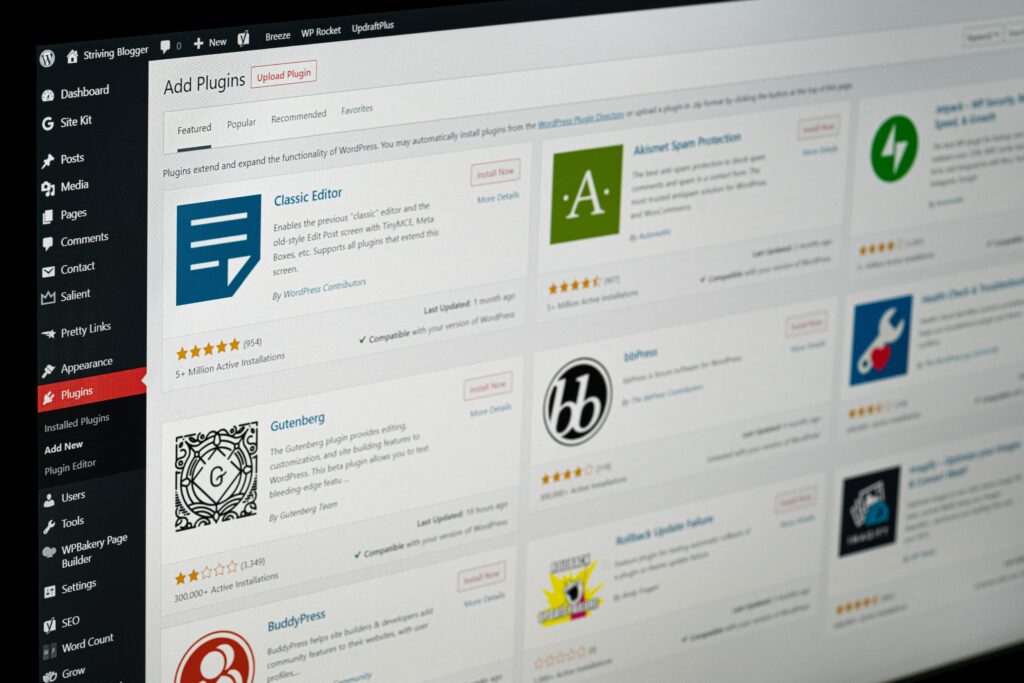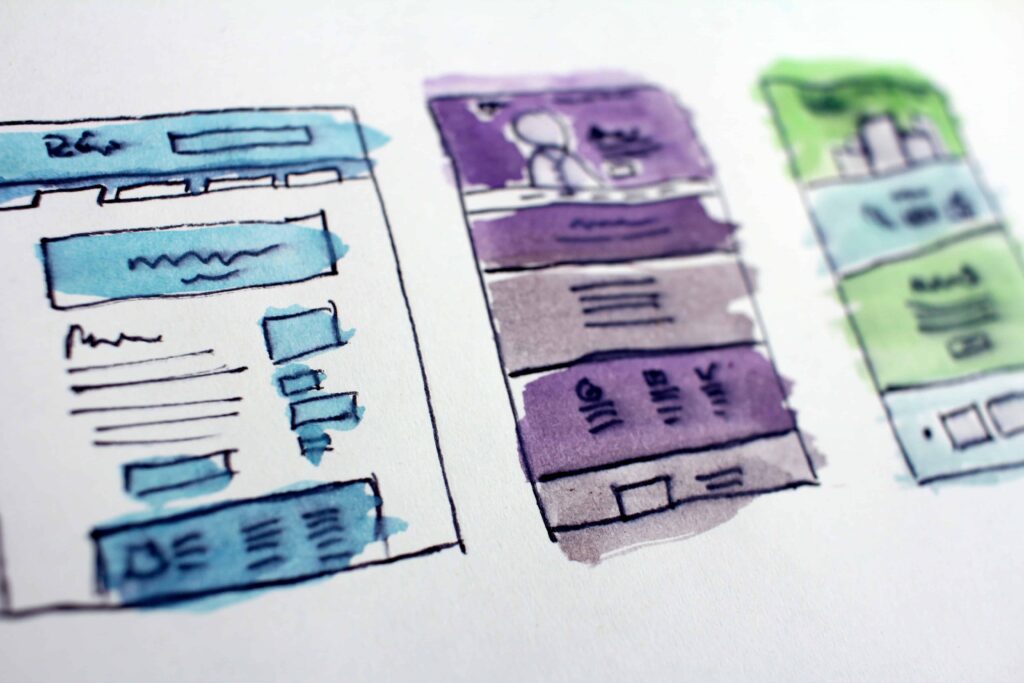So you’ve got an amazing idea for a new business, and a cool business name to go with it. Now you need an online home so people can find you — that’ll be your business website. As a new business, your key aim is getting people you’ve never met to trust you enough to buy what you’re selling. Even if your ‘product’ is your services — your website is your store and first impressions count.
Your website is pivotal in proving your business model works by attracting leads, connecting with them and making sales. In this guide, we cover the key steps you need to cover to launch your business website the right way. Think of this as your shortcut to getting live fast without missing any strategic milestones along the way.
Table of Contents
Site Strategy

User experience is key
First, settle down with the idea that your website is not for you. It’s for your customers. Use the Google algorithm as a guiding light — Google ranks sites higher when they directly address user experience, so match that in everything you do. Good design isn’t about what looks pretty. Good design is what gets more clicks, connections and sales.
Make sure your clients are at the centre of your site architecture. Your site architecture is just a fancy way of saying how the content will be organised on your site. You can also refer to this as your site map, and site navigation within that. Every page you include on your website, and the heirarchy you use to organise those pages should be in direct response to helping users understand what you do and find what they are looking for as fast as possible.
Map business goals to calls to action
You’ll then want to map your business goals with your website calls to action. Decide on 2–3 initial actions that you want users (customers/clients) to take when they land on your website. The first thing most people say to this is ‘Buy’! But what else might that look like? Most service-based startups aren’t set up for ecommerce from the get go. And if you’re getting set up fast, you can just hook up a simple web form and do your invoicing in the backend. With that in mind, instead of ‘buy’ your key call to action might be ‘book a discovery call’. Your ecommerce can then be set up later when you have more time. Furthermore, when you don’t have a ton of social proof yet convincing potential clients that you’re the real deal, you may want to personally get in front of them to prove your value before asking them to hand over their credit card details. Service-based startups with a strong client focus will particularly benefit from this approach as it gives clients time to get to know you. Go live with a simpler set up to test everything out, then build and refine as you go.
So if your business goals are to a) make sales, b) grow your email list and c) increase brand awareness; your site goals might be a) book a discovery call; b) join our mailing list; c) connect with us on social.
Branding & identity

Your brand is the single most important investment you can make in your business.
Steve Forbes
First thing to know is that a logo is not a visual identity, nor is it your overarching brand. A logo is great to have once you know who you are and are ready to create a solid brand presence, but don’t sweat it if you aren’t quite there yet. In fact I always recommend that you don’t invest too much in identity if you’re in the early stages of your business. You likely don’t have the time or the money for such an important investment. Test the waters first and make sure you really have a thing that people want and that can sell.
That isn’t to say that branding doesn’t matter. According to Steve Forbes, “Your brand is the single most important investment you can make in your business.” Getting your identity right is what defines you in the market, it generates trust and professionalism, and shows who you are. But until your business is off the ground and making consistent sales, you’re still working all of that out. Most new businesses change a few things in their first year of business. So keep that in mind for an agile approach to defining your logo, your identity and your overall brand. Then invest in branding properly when you have the knowledge and budget to make it the truly strategic investment it should be.
Three simple branding secrets for a ‘lite’ launch
Use a simple type-based logo. This is a cheaper and cleaner option than getting a cheap logomark that is poorly executed and lets your brand down. If you can’t afford to get a professional custom typographic logo design use your business name in your chosen primary font instead.
Select one primary and one secondary font for your website. You don’t want too many conflicting typefaces on your site, so stick with 2, or 3 max. FontPair is a good resource to help you select freely available Google fonts that will easily integrate with your website.
Select 2 primary colours and 2 paler secondary colours/tints to be used consistently across your website. Coolors is a fun tool for finding great colour palettes. Once you’ve got your colours set, use them consistently everywhere — not just on your website.
Even when you’re starting up and you don’t really have a brand yet, if you can get some basic consistency down in the way you are presenting yourself to the world, it’ll make an impact when it comes to converting leads. Getting this wrong means you’re likely to be lost and forgotten amongst a sea of very similar websites that all look like a template. Worse, a lack of identifiable consistency across your print and digital channels can make it hard to for customers to trust that you are who you say you are.
In short, keep it simple and consistent and you’ll be ahead of the curve. Your web designer can help you get this sorted if you aren’t sure where to start.
Tech setup

Here are the top 5 setup steps to get the technical side of your site hooked up:
- Decide on your Content Management System (CRM). The main options include WordPress, Webflow, and Squarespace, but there are of course many options out there. We use WordPress for all of our website design and development projects, because it has a lot of flexibility for growth. We like building sites that create a solid foundation for things to come — instead of starting over when you’re scaling up, you can build on what you have to expand strategically without redoing work.
- Web host. Your WordPress site will need a web host, basically a place for it to live in the cloud. Dedicated, quality WordPress hosting is well worth the investment as it will deliver you a faster, more secure and functional site than cheaper multi-platform hosts. This is good for your business and for SEO, so don’t skimp. We recommend Flywheel and we include hosting for all of our website care plan clients.
- Next you’ll need to install WordPress, your page builder, choose a base theme (we use a super light theme that won’t add unnecessary features that can slow your site down — and with our sites, the theme actually matters very little as all of our designs sit on top of it), install all the other plugins you’ll need to build your site (common plugins include image compressors, anti-spam, seo) and get everything properly activated and configured the way you want it.
- Connect your domain (this often happens at launch, but we bring it up front for new builds so you can collect leads straight away). Make sure a maintenance page is the first page to go live on your site, with a form for you to collect customer info. Everything else can remain in the background until you’re ready for launch.
- Install an SSL Certificate on your domain for essential added security.
If you don’t have existing knowledge, it’s also worth learning and familiarising yourself with your chosen theme and page builder settings, this may involve doing some tutorials so you know how to setup your site properly.
Getting the technical setup of your website right from the start will save you a load of headaches down the track, so go through it all carefully to be sure you’ve got everything set up the way you need it to be before you start building out your website. Changing setup settings later can open a can of worms and compatibility issues that you may quickly regret, so get advice on the best setup for your business.
Website design

Here are some of the key tasks you should consider to get your business website design right:
- Set your site identity, including your site logo, site title and favicon.
- Apply your chosen colours and typography consistently across your website, ensuring a cohesive look across the site.
- Ensure every page of the site includes a call to action ‘above the fold’ (if you feel you’re coming across a bunch of weird new lingo, you may find our Plain English Guide to Website Terminology handy).
- Design your headers and footers for sitewide use, and any special headers/footers you may need (i.e. minimal versions for your maintenance page).
- Design your pages, but try to minimise the number of separate page layouts (designs) you use. This can get out of hand, fast. And in fact, a lot of templates intentionally use a load of different page layouts so that the end user (you) has options, but they shouldn’t ALL be used. Using every option available just means you end up with a messy site that is unpredictable for your potential clients. Remember, user experience is key, so make sure that when the user lands on a new page, they can navigate that page in a familiar way to every other page on your site.
- Design your blog post template — this is the template the forms the basis for every blog article you write. Ensure this includes a call to action for users to sign up to your newsletter.
- Design popups and forms with associated thank you pages that effectively make the most of the opportunity to help your users make a decision or get to know you better.
- Ensure your site design is optimised for desktop, tablet and mobile.
Content creation

Next you’ll need to add your text, images, videos, and any other content you want included on your new website. This is one thing a lot of small businesses get stumped with, and solving the content delivery problem has been a huge driver behind our content workshopping process here at Studio Clvr. I was at a loose end because clients were always late delivering content for custom website design, so I started to dig down into what the problem was. Most consultants actually have too much to say, as they are understandbly excited by their new business idea. They have a lot of thoughts about where it’s going and ALL THE THINGS they want to do. But ALL the things means the ONE thing that users need to connect with straight away can get lost. Again, this comes back to user experience and giving the client what they are looking for as fast as possible. All of our site designs are now delivered with text prompts ready to fill in, making the writing process less painful and a whole lot faster. Here’s a list of the key things we include to make it easier for business founders to know what to say and where to say it.
- High quality content is key. If you want to convert leads into paying clients, the quality of your content is a key step to building trust and authority. Make sure that everything you write is genuinely valuable, authoritative and useful information. Check your spelling and grammar, it counts.
- Simplify your client’s pain point and your solution into one line that is the first thing users see when they land on your home page (or other relevant page). If a user can’t understand what you do in an instant, they’ll bounce. Pretend you’re explaining it to an eight-year-old and simplify your idea into it’s most basic form. You can change the language later but this exercise is a great way of making sure you aren’t losing your audience by using too many words.
- Tell them straight up what makes you awesome and better than your competitors — what’s your unique value proposition?
- Only use content that drives the desired action for each page.
- Have lengthy prose that you can’t bear to throw away? If you’ve in love with that cleverly crafted essay you wrote for your home page, turn it into a blog post. You need good content for your blog to build organic search rank, and that’s where people can really get to know you. But that long essay doesn’t belong on your home page. TLDR…
- Find, download, resize, compress and upload images to your site — keep the site as light as possible to optimise page loading time. Images are a great way of breaking up content and making it easier to read, but don’t use images for the sake of it. Ensure that everything you use is consistent with your brand, is licensed for use and doesn’t infringe on anyone’s copyright.
- Consider adding graphics to visually represent some of your text and add some variety to your layout — if you have info that can be presented visually do it — visuals are comprehended faster than text. Just avoid anything too naff or cheesy!
- Be sure to embed any videos you upload via a video hosting service (i.e. YouTube or Vimeo), don’t upload them to your site as they will slow your site down.
- Set up any legal pages you may need, most sites include a Privacy Policy and Terms of Use. We recommend Termaggedon to make this really easy.
Integrations & automation

Starting a new business is hard. Most founders are going it alone or working as part of a very small team. That means you’re wearing a lot of hats from day one. And chances are that most of those hats are for jobs that are not in your core skillset. The good news is that even if you don’t have a budget to hire help just yet, there are a lot of things that you can do to make your life easier and reduce the administrative burden of building your client base.
Here’s a list of the key integrations we recommend to help automate your digital business:
- Social media: this is an obvious one, but connect your social accounts to make it easy for users to connect with you and for efficient content sharing.
- Appointment bookings: set up your availability in your calendar allow clients to book an appointment with you 24/7 at a time that suits them. No more back and forth to find a suitable time and date. Calendly is free for one integration, and is all you need to get started.
- Email marketing: connecting email to your calendar and other site forms allows you to set up automated email sequences to communicate with leads without requiring you to lift a finger. For example, when a client books an appointment, your email software can automatically send them a welcome email telling them what to expect and any details they need to know for the meeting. You can set up appointment reminders, and follow-ups too. Maybe send them a form after the meeting? All of this makes you look super professional, makes sure no leads slip through the net, and is essesntially the most affordable admin assistant ever. And that’s just the tip of the iceberg regarding what you can be doing with automated email marketing.
- Analytics: hook up an analytics service. We use the affordable paid tool, Fathom Analytics as we’re all-in on data privacy over here. There are other options (note that if you’re using a free analytics tool like Google Analytics, you are paying with your business data and the private data of your often unconsenting website visitors). Getting analytics set up early is essential for you to measure the success of your website in many ways, from how well you’re converting leads, to the popularity of your blog content. Having the data will help you to jump on opportunities when you see things working well and make quick changes when your conversion rate is low. Analytics are key to making informed decisions regarding any changes to the site setup, design or content going forward.
- Client Relationship Management (CRM): you ideally need an easy visual tool that allows you to see all of your leads, subscribers, buyers, and segment them depending on what stage of the buying cycle they are in (are they researching or ready to buy?). Don’t panic, this doesn’t have to be an all-in, expensive product. But having a system for this is essential to ensure that you don’t miss any opportunities, and that you have a really clear sense of how the business is tracking at all times. Hubspot and Freshworks have free basic CRMs, and you can build your own simple solution using Trello or Airtable combined with a code-free API hookup tool like Zapier or Integromat.
- e-Commerce: if you’re selling services or products, you’ll also need to integrate a payment gateway (i.e. Stripe or PayPal) and will need to connect that to your accounting software (i.e. Xero) to ensure all of your sales are neatly reconciled and to prevent a bookkeeping nightmare. We don’t do big e-Commerce sites (because Shopify is the best place for those), but we do recommend productising services wherever possible and setting up relevant sales channels for simple products on your WordPress site.
Having a clear picture of your user journey can be really helpful to work out what automations and integrations you need at different stages of your sales funnel, so map that out first to get really solid on what you want to achieve.
Launch

By the time you get to launch, it can be easy to overlook final checks. I get it. You just want to go live and move on to the next item on your growing to-do list. Most people will find at least one thing that isn’t working as intended when they go through this list. Better that person be you that a potential client, who might be turned away!
- Check the WordPress display settings are properly connecting your Home page and blog page.
- Check all buttons and links to make sure everything clicks through to what it’s meant to click through to. Make sure you’re using relative links (i.e. /articles instead of https://studioclvr.com.au/articles).
- Test all forms including email receipt and notifications, along with redirects to relevant thank you pages.
- Delete any pages, posts, media, text snippets that you don’t want on your live site, and to clean out any unnecessary content that could slow your site down.
- Deactivate any plugins that you don’t need. Check your site is still functioning properly before deleting the plugins, once you’re sure everything is good you can delete them to save space.
- Turn on search indexing. You want to be sure Google can find you! If you’re using an SEO plugin, make sure you’ve added all of your page title and description tags.
- Add your site title and site tagline to the WordPress settings area, just to be sure if anything glitches, the correct tagline is displaying rather than the default ‘Just another WordPress site’.
- Connect your domain (if you haven’t already), activate SSL and enable https for required security.
- Submit your XML sitemap to Google and Bing (SEO plugins like SEOPress make this easy).
- Test! Test! Test! Check your site on different browsers and different devices to be sure everything is working properly before you officially go live.
Don’t stress, if you’re using our custom website design services, we’ll do all of this stuff for you. Just pull up a chair and wait for the magic of go live!
Promote

Email marketing has an ROI of 4300% and ... is 3x more effective at converting leads to sales than Facebook and Twitter combined
McKinsey
Woo hoo! You’re live! But now you need to tell folks your site exists so you can actually start seeing visitors, getting clicks and making sales. There are a lot of easy ways to get traffic to your website. Here are the main promo tips I’ve had success with, and that are important not only for longterm growth, but also to help give you an organic base that will boost any ad spend you devote to paid campaigns. If you need help with any of these digital marketing services, we can help for a day, or via our VCMO program.
- Add your new web address everywhere — in your email signature, on your socials, everywhere.
- Get your site set up with solid SEO Foundations to ensure everything you’re doing is optimised for search engines.
- Set up a Google My Business (GMB) page. I can’t tell you how amazing this quick win is for local search. I regualarly get new leads thanks to my GMB page. Be sure to verify your business address with Google.
- Ask clients/customers for Google reviews. Once you are set up in GMB, you’ll be able to start collecting reviews, and will have a link that you can send to clients.
- Strategise hard on your content and social media plan and start blogging. Consistently adding content to your site not only helps to address search intent and improve your search rank for being a helpful source of knowledge, but you will also improve in the SERPs just for having updated content on the regular.
- Set up email marketing and start building your list. Email converts at a better rate than any other marketing channel and according to the Direct Marketing Association, email marketing has an ROI of 4300% and according to a McKinsey report, is 3x more effective at converting leads to sales than Facebook and Twitter combined.
- Sign up for PR opportunities and get access to journos looking for experts on all sorts of topics. This can be an easy way to get you some backlinks (great for SEO) at the very least, or some really good exposure, depending on the publication.
Are you ready to workshop the website strategy for your business?
There’s a LOT involved to ensuring your business website is off to the right start with the right foundations. If you are ready to build your business operations through the lens of your website, you will have a clever edge that will help your business grow and thrive. At Studio Clvr, we offer an obligation-free website strategy workshop to help you solidify your foundations so you can move on to the next step in your business journey with confidence.
